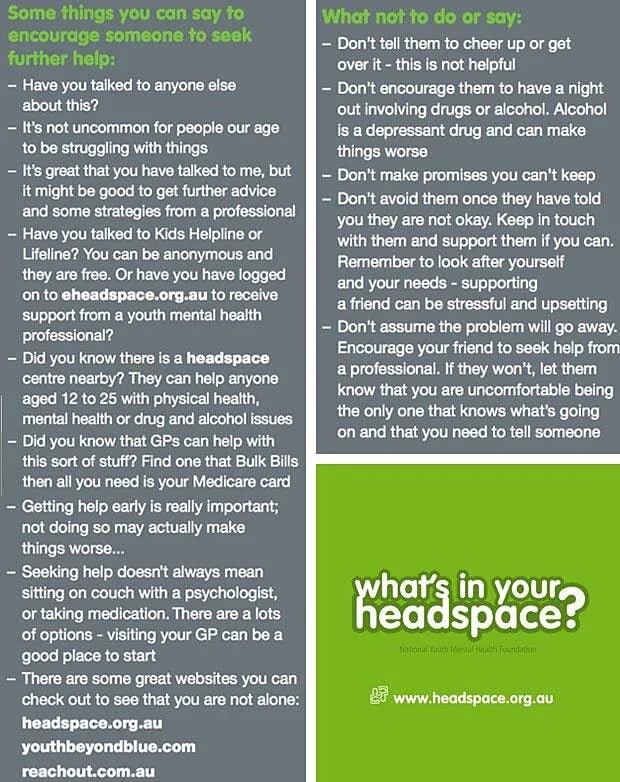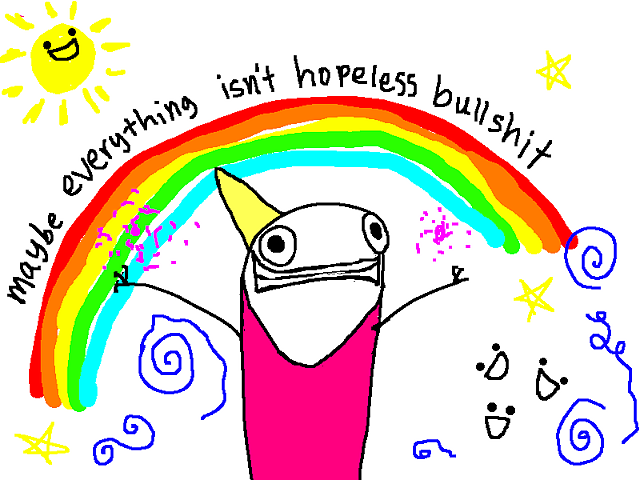How To Talk About Depression If You Ask ‘R U OK?’ & The Answer Is ‘Nope’
By Claire Bracken
Updated July 29, 2017
Almost half (45%) of all Aussies will experience a mental illness in their lifetime, one in seven will experience depression and every day at least six Australians die from suicide, with a further thirty people attempting to take their own life. Suicide is the biggest killer of young Australians and takes the lives of more of us than car accidents.
By that reckoning everyone in this country, whether they realise it or not, has been or will be affected by mental illness at some point in their life.
A massive international survey recently found that 50% of all lifetime cases of mental health disorders start by age 14 and 75% by the age of 24. Last year an Australian survey found the things that bum young people out the most are: coping with stress, school or study problems, body image, depression and family conflict, in that order.
The same survey found that young people saw mental health as a more important issue than things like the environment, bullying, education or employment. So, we know we care about dealing with mental health but what next?
WHY DON’T WE TALK ABOUT DEPRESSION AND SUICIDE?
One of the many stories the Propeller Project (an Aussie initiative sharing the stories of young Aussies making a difference in their communities) captured is from Aiden, whose life was touched by depression and the attempted suicide of his best friend, Amelia. Aiden came to realise that for some Aussie kids it seemed easier to take their own lives than it was to open up and talk about what was going on for them. That’s when he started the SwishStart program; to help other kids learn about mental health through the magic of basketball.
We’ve since had a chat to Aiden and one thing he wishes everyone would know about depression and suicide is that “It’s okay not to be okay.”
No doubt talking about depression and suicide is heavy but the alternative is worse, considering there’s still a lot of gaps in what we think/know about it all. When we spoke to Aiden he mentioned the myth that “if you ask people about suicide you put the idea in their head, when in reality years of research suggest the opposite, that if you talk to them about it they’re less likely to suicide.”
In her book ‘Is There No Place For Me? Making Sense Of Madness’ Kate Richards talks about how suicide is debated as either a brave or cowardly option when, in fact, it is neither – “It is the tragic, potentially preventable result of severe psychic pain coupled with a false belief about the self as ‘a failure’, as ‘damaged’, as ‘damaging to loved ones’, and a complete absence of hope for recovery.”
For the most part, the stigma – especially for men who, in Australia, account for 60% of deaths by suicide – is still surrounding the perceived weakness of sufferers, as if depression and suicidal thoughts are something you can just shake off.
As outlined in a report (‘The Hidden Toll’) presented to the Australian Senate in 2010, this perception of appearing weak has contributed to the fact that an estimated 72% of males with a potentially diagnosable condition don’t seek help for mental disorders. We only need to look at recent events – such as the shock and confusion surrounding Robin Williams‘ death and of the disdain with which the media treated the death of Phillip Seymour Hoffman, especially the Daily Telegraph with their disgraceful ‘junkie actor dad’ headline – to see how warped the collective reaction to mental health issues can be.
Even people whose life’s work is to study the brain can admit to how little we actually know and that’s coo’ – what an adventure! – but we certainly know enough to recognise that treatment needs to be a combination of medical + psychological help, coupled with the support of those around you, and is most likely going to be an ongoing process. Treatment can’t happen if no one knows what’s going on, though.
WHY WE SHOULD TALK ABOUT DEPRESSION AND SUICIDE.
Stanford Professor Robert Sapolsky said, in the A+ lecture he gave on the topic, “So there are all sorts of these great made-for-TV movie diseases out there, but when you want to come to the basic meat and potatoes of human medical misery there is nothing out there like depression – it is absolutely crippling, incredibly pervasive and thus important to talk about.”
Throughout his talk – which is essentially about the biology and psychology of depression and can be found HERE -Sapolsky makes the argument that it is basically the worst disease you can ever get. He finishes with: “The single thing I want to emphasise over and over — this is not ‘oh, pull yourself together, we all get depressed’ this is as real of a biological disorder as diabetes.”
Long and short of it is: depression is a bummer. At its root it is a temporary inability to feel pleasure – an inability to feel pleasure – and no matter how much we want to be able to ~positive vibes~ it away, sufferers of the disease need and deserve more than that.
WHAT ARE THE ‘SUICIDE WARNING SIGNS’?
Another person who received a grant and was followed around with a camera as part of the Propeller Project is Tiana. She too was blindsided by the death of a loved one, her best friend Shae, and was subsequently occupied with the torturous ‘What if…?!’ It was through this that she recognised a gap, a gap for people like Shae – who feel suicidal but haven’t spoken to anyone about it – to fall through. How, then, was someone to get help if no one in their life knew they needed it?
It was then that she identified the seven ‘Suicide Warning Signs’, had them signed off on by mental health experts, and decided to print them on business cards and take it upon herself to hand them out in public places. She has since continued with her initiative ‘Alive‘ and whilst she’s currently working on fixing up the site, you can still order the cards for yourself to distribute as you will.
One thing that Tiana found when she started handing out the cards, was just how many people had been affected by suicide. While most had known of someone who had committed suicide the overwhelming belief that it’ll never happen to someone close to you still persisted. “It can really happen to anyone. You don’t expect it to happen to someone around you, though.” She continued: “I was always like ‘oh, it’ll never happen to me, it’ll never happen to any of my friends and so I didn’t know anything about it.”
As for what’s on the cards, which she hopes to eventually bring into all high schools across Australia:
The Seven Suicide Warning Signs
1. Making direct or indirect threats about suicide
2. Dramatic changes in personality or mood
3. Changes to eating & sleeping habits
4. A dramatic drop in performance at school or work
5. Feelings of guilt or low self esteem
6. Saying goodbye and giving personal belongings away
7. Withdrawing from friends and family
On the topic of warning signs, an article which has always stuck with me, especially having grown up hearing characters in books, film and television and IRL humans refer to those who commit suicide as people who had ‘taken the easy way out,’ is ‘Why Men Commit Suicide: The Three Warning Signs Most People Miss.’
The author talks about a theory by Thomas Joiner, Ph.D, on what key motivational aspects contribute to suicide. These are: 1) a sense of not belonging, of being alone, 2) a sense of not contributing, of being a burden 3) a capability for suicide, not being afraid to die. The third reason especially would explain why so many people within army and police forces are being lost to suicide.
Joiner proposes that, “All three of these motivations or preconditions must be in place before someone will attempt suicide.”
It can be easy to miss these signs especially when you consider how many of us plaster on a chill-fun-time-bro mask when we’re not feeling great, but the more informed we become the more likely it is we’ll be there to catch one another.
HOW DO WE TALK ABOUT IT?
beyondblue was founded in 2000, as a community response to the World Health Organization‘s finding that depression is the leading cause of disability worldwide. We recently spoke with beyondblue’s Deputy CEO Dr Brian Graetz, who told us that their four core messages are Look, Talk, Listen and Seek Help. Obviously those messages are great but they also found that “young people, and adults, don’t really know how to have that conversation if they’re worried and don’t know what they would do if the person they spoke to actually said ‘well, no, I’m not doing that well’…”
We, as a generation, are certainly more comfortable with the idea that mental health is something that needs to be paid as much attention as your physical well-being but it’s still not an easy conversation to have. As a response to this insight, beyondblue developed the Check-in app to ‘help take the fear out of having a conversation with a friend who might be struggling,’ which can be downloaded HERE.
Another organisation who work tirelessly to help Aussies out, one with a great tagline and an even greater mission statement is Soften The F*ck Up; they’re all about exactly what it sounds like they’re all about. They have been sharing the below video to remind anyone worried about starting a hard conversation of one thing – which cannot be emphasised enough – that the simple act of caring about your fellow humans and making the effort to see if they’re okay, is what is most important.
Just start with a question.
For help developing a more targeted line of questioning: Headspace do a great job of being there for young people, specifically, and have put together info on getting the party started, how NOT to react and what your next steps are.
For more of the same or to find a Headspace centre or to use eheadspace from the comfort of your own home head to www.headspace.org.au.
FOR EVERYONE GOING THROUGH THIS
We can all agree that it really would be great if depression and suicidal thoughts would please go away. In the meantime, though, our understanding of mental health is ever-evolving and the loose canon known as the human brain continues to give up its goodies/secrets. Whilst there’s still people who are going to misunderstand and make you feel dang for your occasional inability to feel pleasure there are always ways to reach out to people who get it.
The best defence against the black is to join all of our brains together in sickness and in health to get each other better and ICYMI Adventures in Depression + Depression Part Two by Allie Brosh. Because, at the end of the day, ¯_(“~)_/¯
If you or someone else is in an emergency situation, please call 000 immediately.
To contact the Mental Illness Fellowship of Australia call their national helpline on 1800 985 944.
To reach SANE, a national charity helping Aussies affected by mental illness lead a better life, call their helpline on 1800 187 263.
If you or someone else needs support in a crisis situation please holla at Lifeline on 13 11 14.








